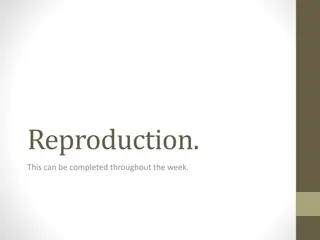Understanding Animal Reproduction: Key Concepts and Life Cycles
Exploring the fascinating world of animal reproduction, this lesson covers the basics of how animals produce offspring, including the parts of an egg, differences between tadpoles and adult frogs, stages in the life cycle of a cockroach, and distinctions between larvae and nymphs. It also delves into the care of mammal babies and the life cycle of a frog. Engaging images enhance learning and understanding throughout the content.
Download Presentation

Please find below an Image/Link to download the presentation.
The content on the website is provided AS IS for your information and personal use only. It may not be sold, licensed, or shared on other websites without obtaining consent from the author. Download presentation by click this link. If you encounter any issues during the download, it is possible that the publisher has removed the file from their server.
E N D
Presentation Transcript
REPRODUCTION IN ANIMALS Lesson 8
E. Write short answers. 1. What is reproduction? Ans : The process by which animals produce babies is called reproduction.
2. Name the main parts of an egg? Ans: The main part of an egg are Shell, Yolk, albumen and embryo. 3
3. How is a tadpole different from an adult frog? Ans: A tadpole this a baby frog. It has a tail and looks like a fish. It swims in water and eats water plants. It changes into a frog. A frog has legs. It lives both on land and in water. 4
4. Name the various stages in the life cycle of a cockroach. Ans: The stages in the life cycle of a cockroach are egg, nymph and adult. 5
5. Differentiate between a larva and nymph. Ans: A nymph looks like the parent insect. The larva looks different from the parent insect. 6
F.Answer these questions. 1. How do mammals take care of their babies? Explain. Ans: When the babies of mammals are born, they are weak and helpless. Usually, the mother takes care of her babies. She feeds them and protects them from enemies. In some mammals such as monkeys and wolves, the father also take care of the babies. He guards and protects them from enemies. 7
2. Explain how a chick comes out of an egg. Ans: The mother hen lays an egg and then sits on the egg to keep it warm. After a few weeks, the chick hatches out by breaking the shell. 8
3. Describe the life cycle of a frog. Ans: A female frog lays hundreds of eggs in water. When the eggs hatch, tiny baby frogs called tadpoles come out of them. A tadpole has a tail and looks like a fish. It swims in water and eats water plants. Later, it grows legs. The tail also becomes shorter and disappears finally . Gradually, the tadpole changes into an adult frog. 9
4. How do the eggs of crocodiles hatch? Ans: A female crocodile digs a hole in the ground and lays eggs. She then covers the egg with dirt. After two or three months, the young one are ready to hatch. The mother crocodile removes the dirt and helps the young one to come out. 10























